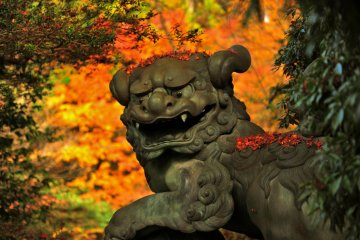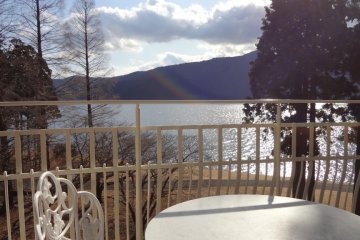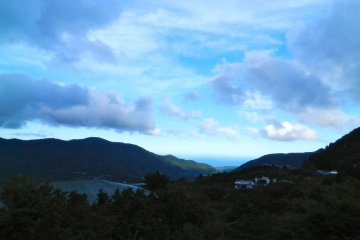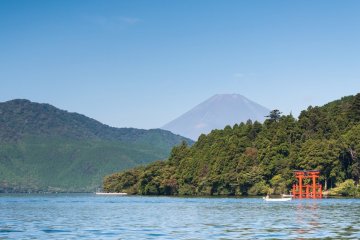
ศาลเจ้าฮาโกเนะ: เทพพระเจ้าแห่งโชคลาภ
Masayoshi Hiroseผมต้องเปลี่ยนแผนการถ่ายภาพภูเขาฟูจิเพราะสภาพอากาศไม่ดี โดยการเข้าชมศาลเจ้า 'Kuzuryu หรือศาลเจ้าฮาโกเนะ ริมทะเลสาบอะชิ (Ashi)

The Hakone Shrine is a Japanese Shinto shrine on the shores of Lake Ashi in the town of Hakone in the Ashigarashimo District of Kanagawa Prefecture. It is also known as the Hakone Gongen. [Wikipedia]

ผมต้องเปลี่ยนแผนการถ่ายภาพภูเขาฟูจิเพราะสภาพอากาศไม่ดี โดยการเข้าชมศาลเจ้า 'Kuzuryu หรือศาลเจ้าฮาโกเนะ ริมทะเลสาบอะชิ (Ashi)

ในย่านรีสอร์ตของฮาโกเนะนั้นมีโรงแรมทั้งเล็กทั้งใหญ่จำนวนมากจนทำให้คุณอาจเลือกไม่ถูก ซึ่งปัญหานี้ก้เกิดกับทุกคน! ถ้าคุณเป็นคนที่ชอบอะไรเรียบ ๆ ง่าย ๆ : "เดอะ ปรินซ์ ฮาโกเนะ"


เรียวกังโกะไซกันเป็นเรียวกังที่ดีในฮะโกะเนะ ที่สามารถเข้าถึงระบบการขนส่งในเทือกเขาฮะโกเนะได้สะดวกมาก

ที่ปัน-โนะ-มิมิ คุณสามารถลองอาหารที่ทำจากขนมปังแสนอร่อยและมีเอกลักษณ์เฉพาะตัว ควบคู่ไปกับแซนวิชอุ่นร้อน อย่างทูน่าชีส หรือแฮมและเชดดาร์ อย่ามองข้ามขนมปังกราแตง—ที่นี่ขึ้นชื่อเรื่องกราแตงทะเลและชีสที่อบในขนมปังสดครึ่งก้อน

บ็อกซ์ เบอเกอร์ เสิร์ฟแฮมเบอร์เกอร์เนื้ออาชิการะที่ดีที่สุดในจังหวัด เมื่อคุณสั่งเบอร์เกอร์เนื้อหนาฉ่ำ อย่าลืมลองสั่งมิลค์เชคโฮมเมดมาทานคู่กัน ลองกาแฟแวนคูเวอร์ของที่นี่ ซึ่งเป็นแบรนด์ของอัตสึงิ และทำจากเมล็ดอาราบิก้าของเกียวโต ซึ่งจะทำให้คุณรู้สึกกระปรี้กระเปร่าตลอดการเดินทางที่เหลือของคุณ!

ร้านอาหาร Togendai View Restaurant ร้านอาหารบรรยากาศดีๆริมฝั่งทะเลสาบอะชิ

Over 3,000 years ago, Mount Hakone’s eruption created a large volcanic crater, leading to the formation of Lake Ashi (Ashi-no-ko) in Hakone, Kanagawa Prefecture. This stunning work of nature has become iconic thanks to its breathtaking views of Mount Fuji. On clear days visitors can see the unmistakable mountain rising above the trees and, occasionally, witness its reflection in the still waters. Surrounding Lake Ashi is a relatively undeveloped coast of lush woods and quaint onsen towns. Nestled in the forests encircling Lake Ashi are notable destinations such as Hakone Shrine, the Hakone Detached Palace Garden, and Moto-Hakone. Hakone Shrine, located on the southern end of the lake, is situated just off the shore with its red torii gate seemingly floating in the water and its similarly vibrant shrine buildings standing sheltered in the trees. Also located on the southern shores, is the Hakone Detached Palace Garden, a remnant of the summer palace for the Japanese Imperial Family. The garden, called Onshi Hakone Park, has scenic walking trails and some of the area’s best views of Mount Fuji. Nearby the garden is Moto-Hakone, which is one of the towns where boat tours often depart. Apart from the town’s port activity, Moto-Hakone is regarded as another prime location to observe Mount Fuji.

Be awed by storm clouds of volcanic steam that gather over the active volcano, Owakudani (大涌谷), the Great Boiling Valley. Created around 3,000 years ago, today the crater-valley is a popular tourist site, despite the ominous and evocative name. The volcanic valley is still alive today with active sulfur vents and hot springs. Once called the “Grand Inferno” or “Great Hell” thanks to the streams of white sulfuric smoke reaching toward the sky, it was renamed when the Meiji Emperor and Empress visited Hakone in 1873 because locals hesitated to invite the two to a place with such a foreboding name. Marvel from the Hakone Ropeway, 130 m above the valley bottom. Sulfur and water vapor pour out at about 100°C. The terrible landscape creates an image of hell that had even famed Japanese Buddhist monk, Kūkai, offer a prayer to Bodhisattva at the sight. At sunset, the sunlight from Lake Ashi glitters off the waters to offer a beautiful sight one might not expect next to the nightmarish landscape. While here, be sure to try the legendary kuro-tamago—hot spring hard-boiled eggs with shells turned black by the iron sulfide in the volcanic waters—these treats are only available at Owakudani. Eating one is said to add seven years to your life. At the top of the observation deck overlooking Owakudani you might even spot the majestic Mount Fuji on a fine day, this being one of the best spots to see it from. Access Owakudani by the Hakone Ropeway from Owakudani Station, or by bus. Although it is advised that people with asthma, bronchitis, heart disease, pacemakers, and pregnant women not enter the valley due to high volcanic activity. The volcanic gas concentration and temperature are constantly measured at the Hakone Ropeway stations to ensure the safety of guests and the site may be temporarily closed due to high levels of gas or volcanic activity. Volcanic alerts were lifted on Friday Nov 15th 2019, ending a six-month closure that saw most parts of the Owakudani area temporarily closed to access due to an increase in volcanic gases. The area is now safe to access, though it is advised that those with respiratory problems, heart conditions, pregnant women or young children do not enter the valley due to slight risk from volcanic fumes.

เดินเล่นไปรอบ ๆ สวนออนชิ ฮาโกเนะ (Onshi Hakone) เพลิดเพลินกับต้นซากุระหลายๆ พันธ์ และวิวของภูเขาฟูจิเหนือทะเลสาบ จะทำให้คุณสุขใจ